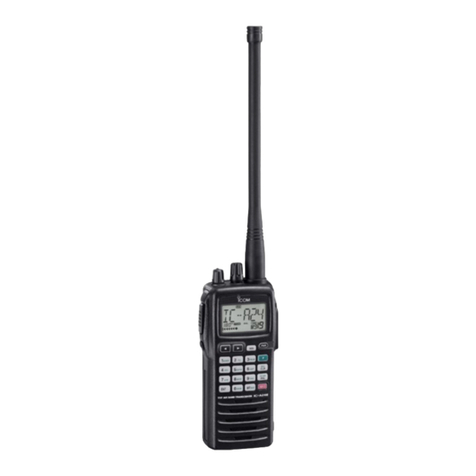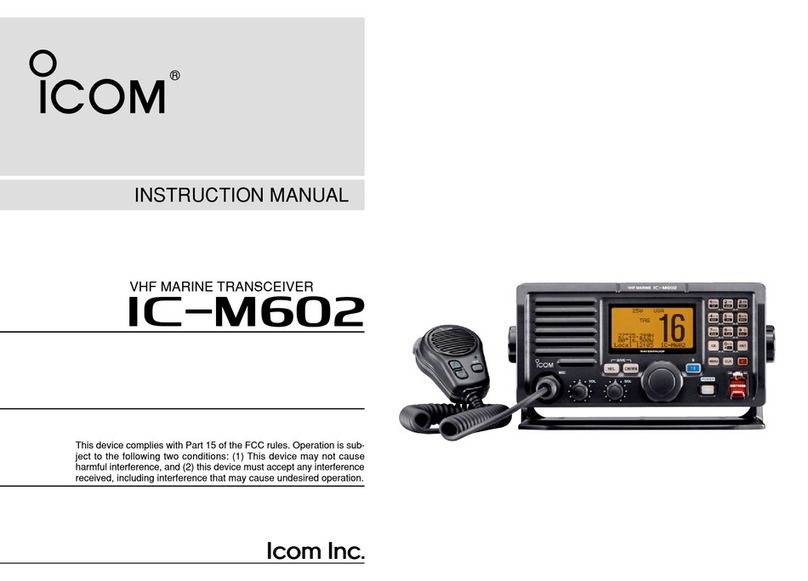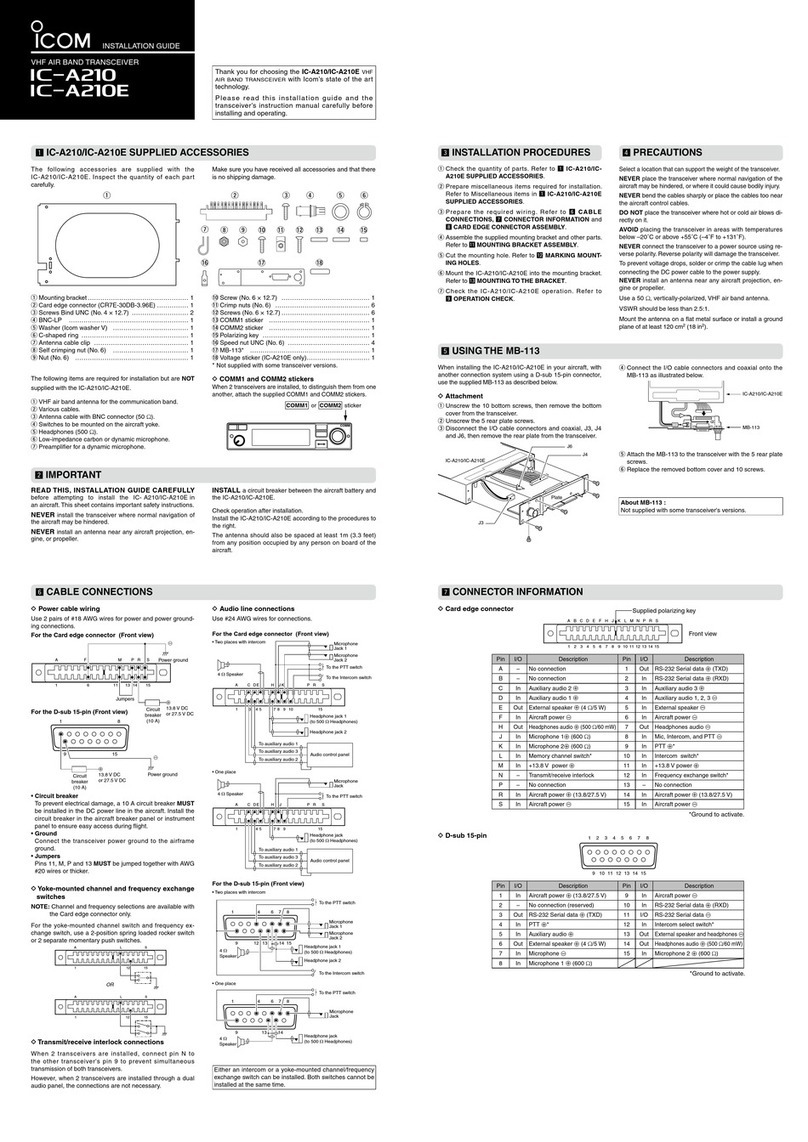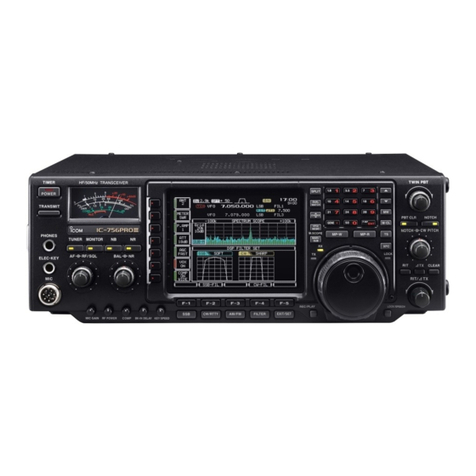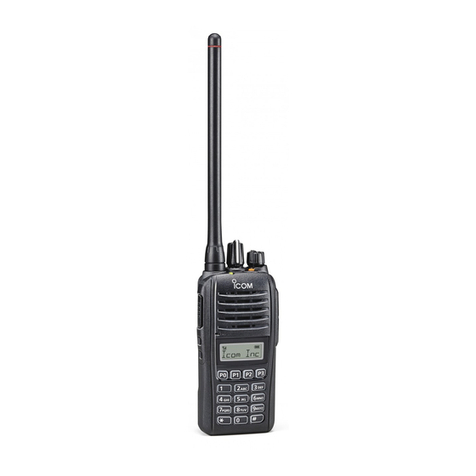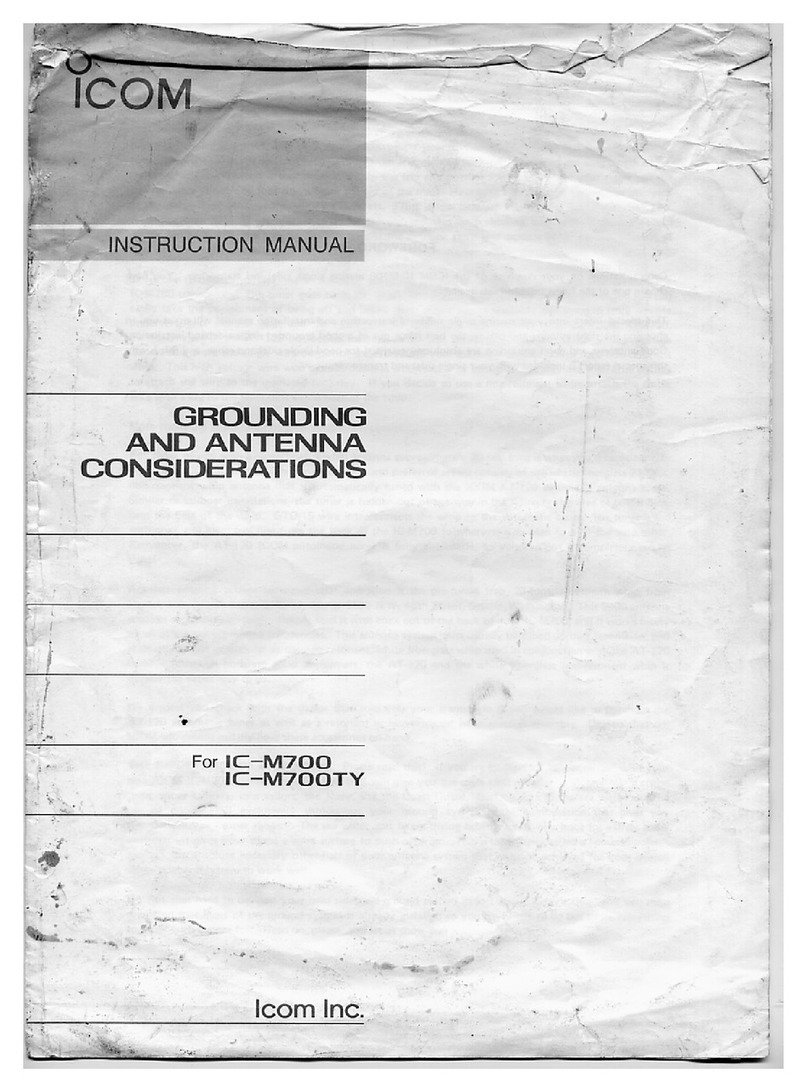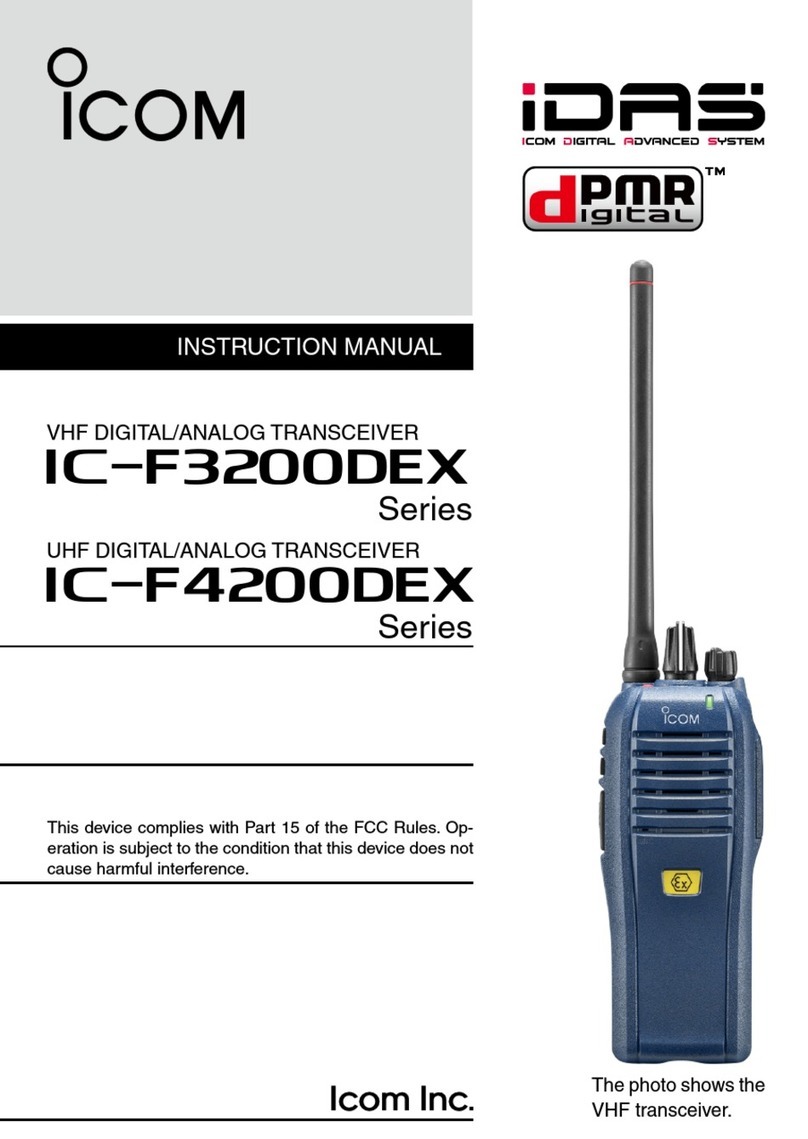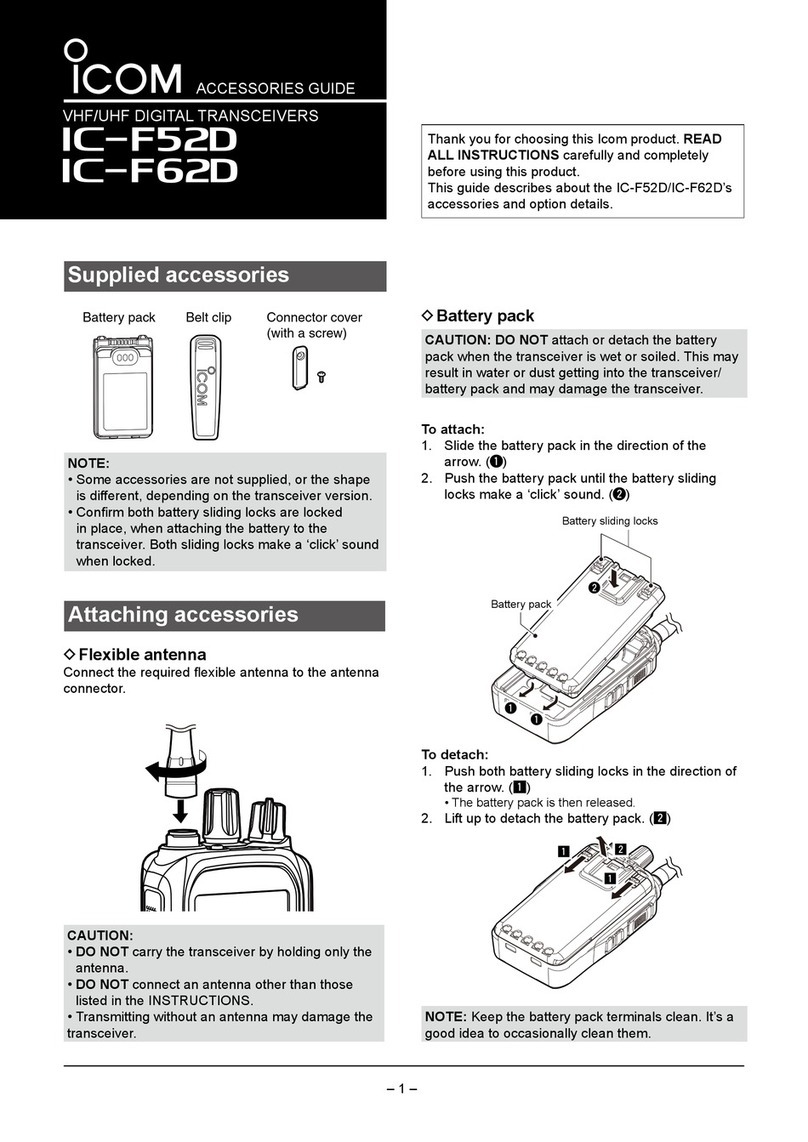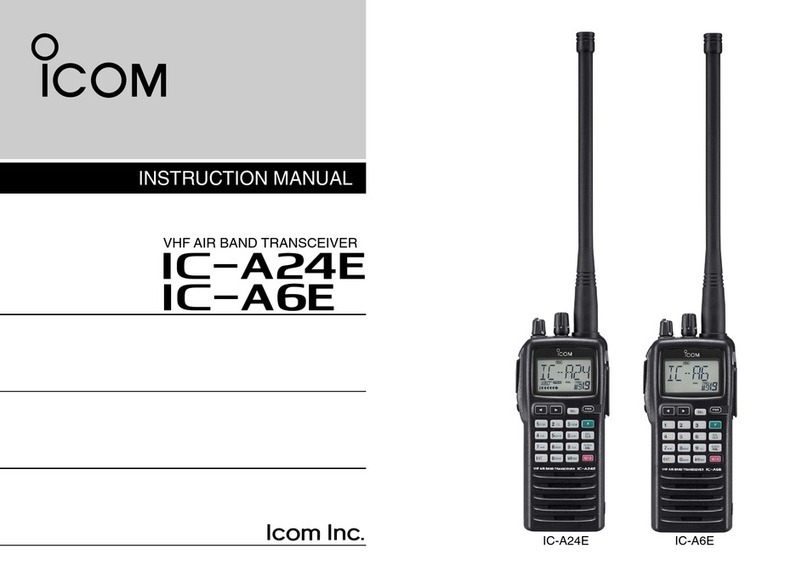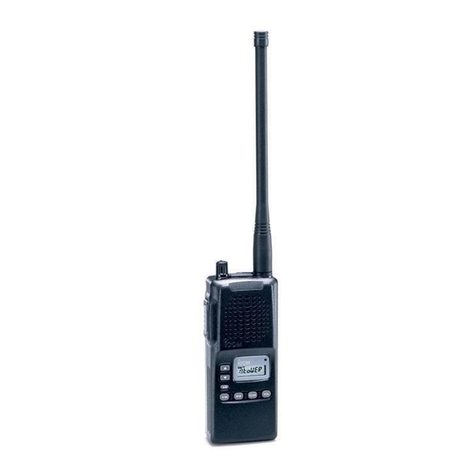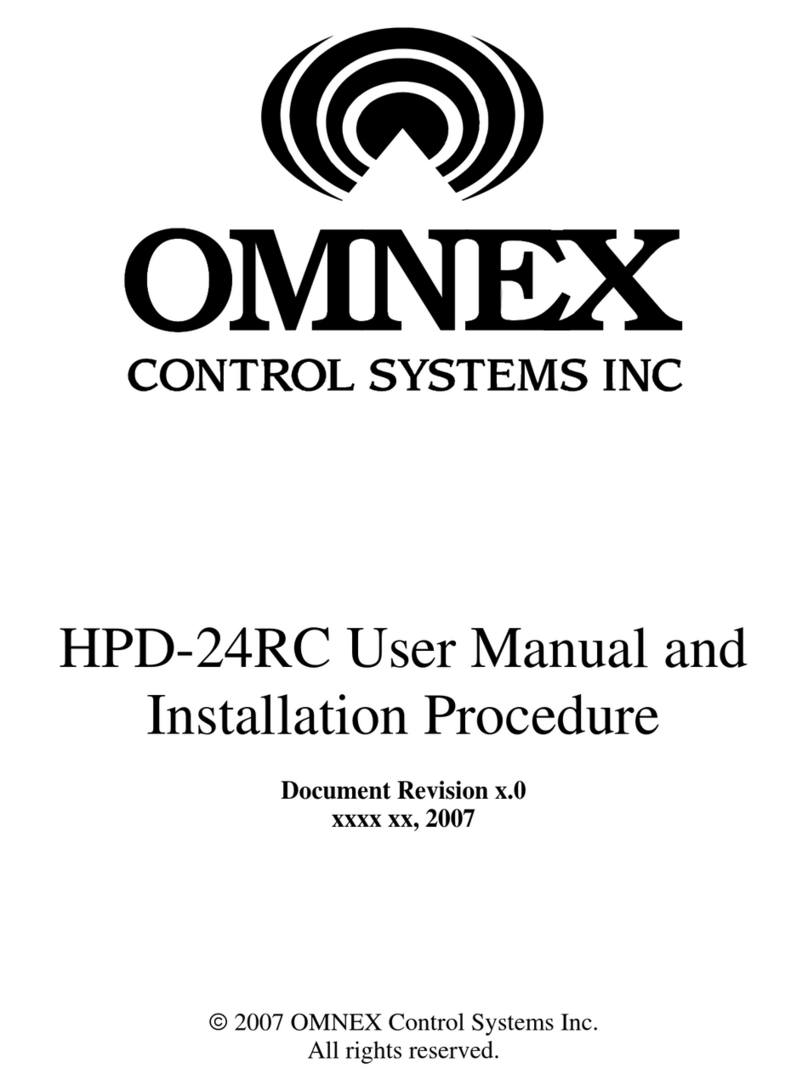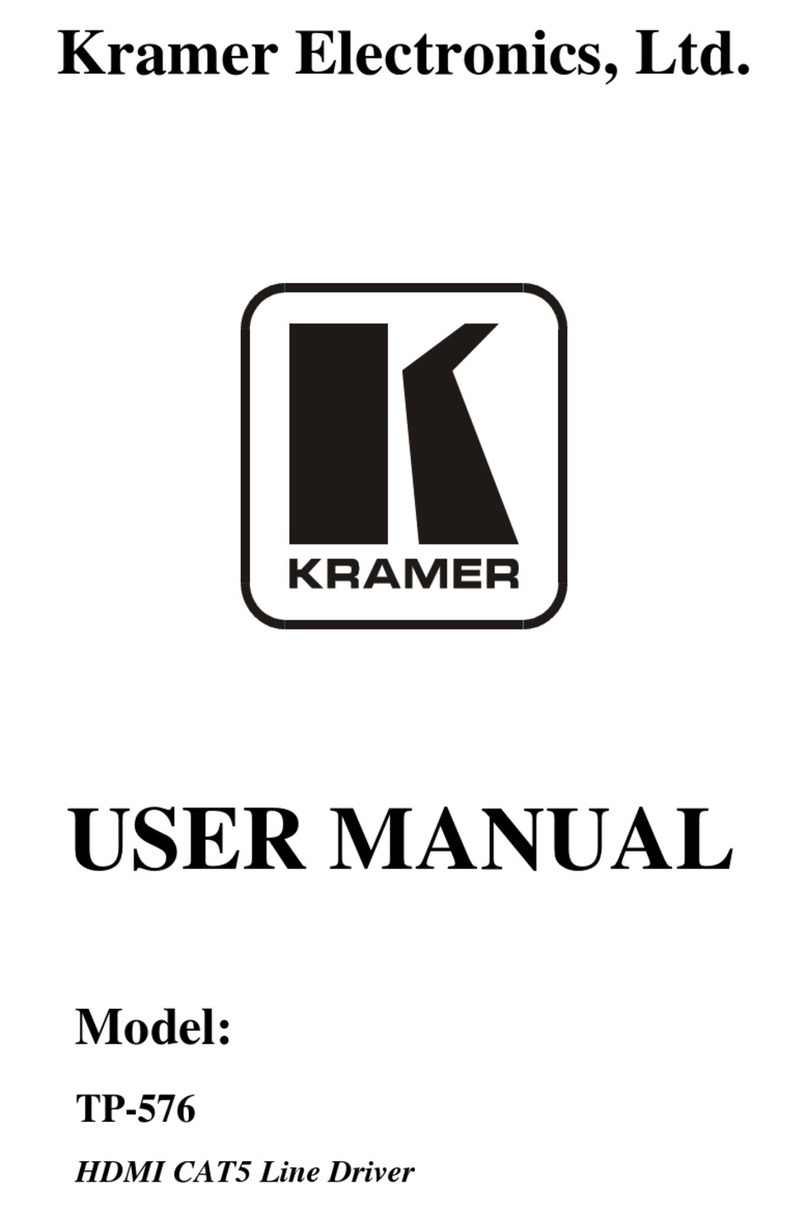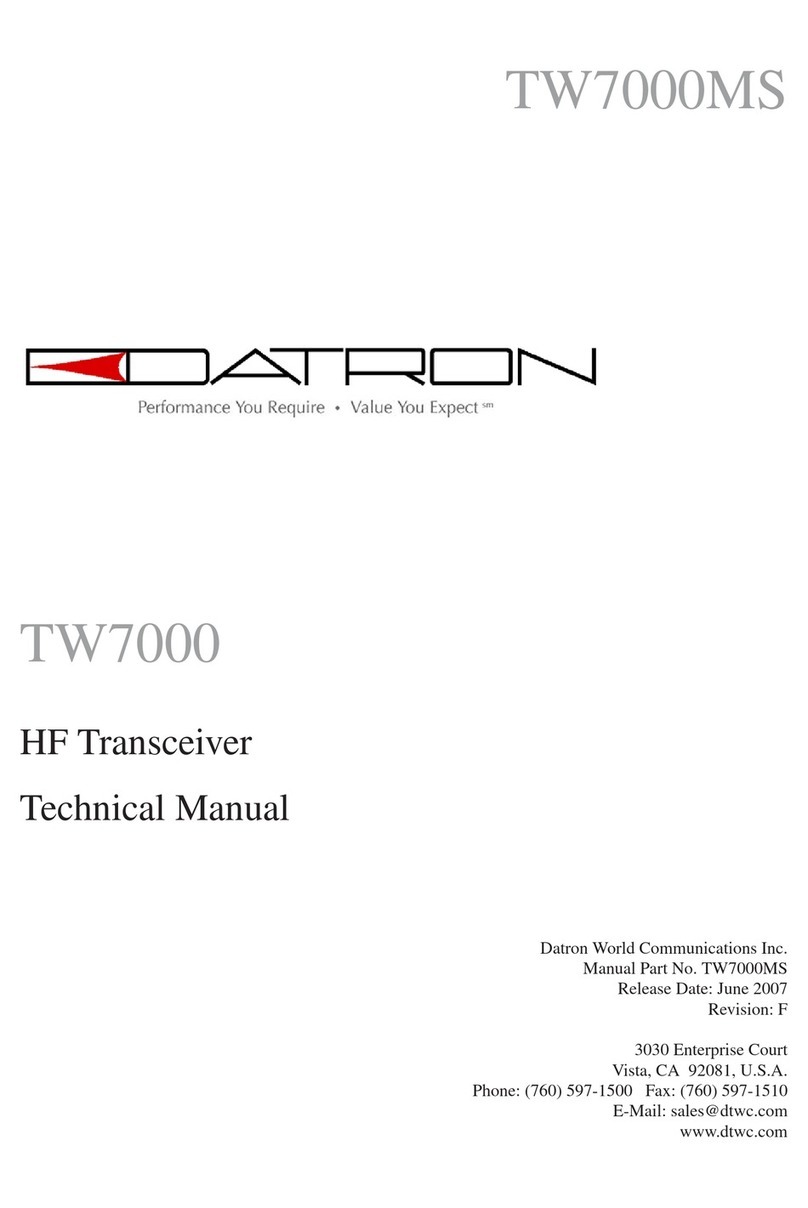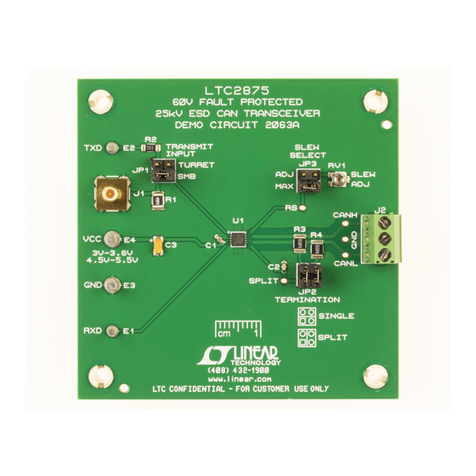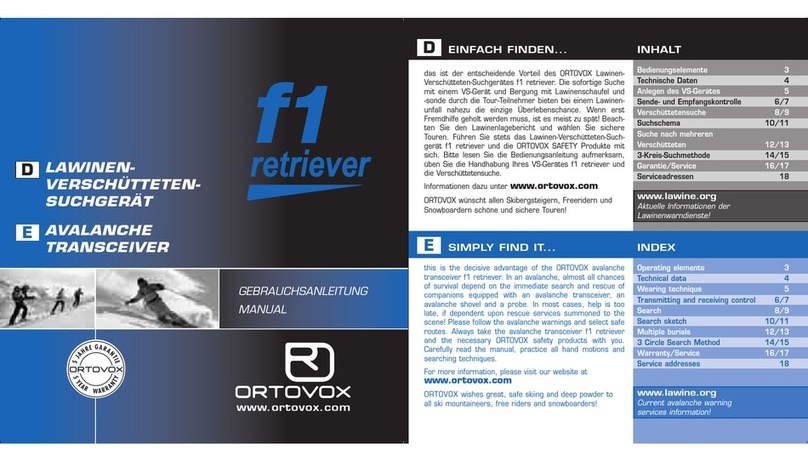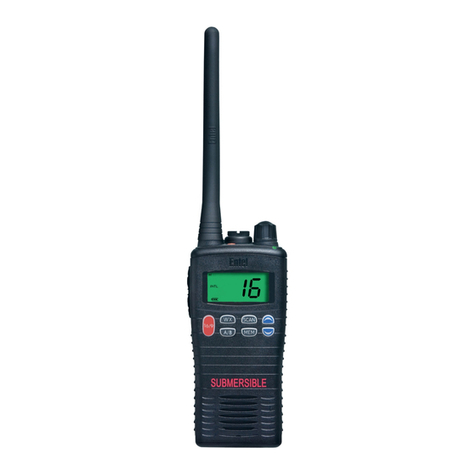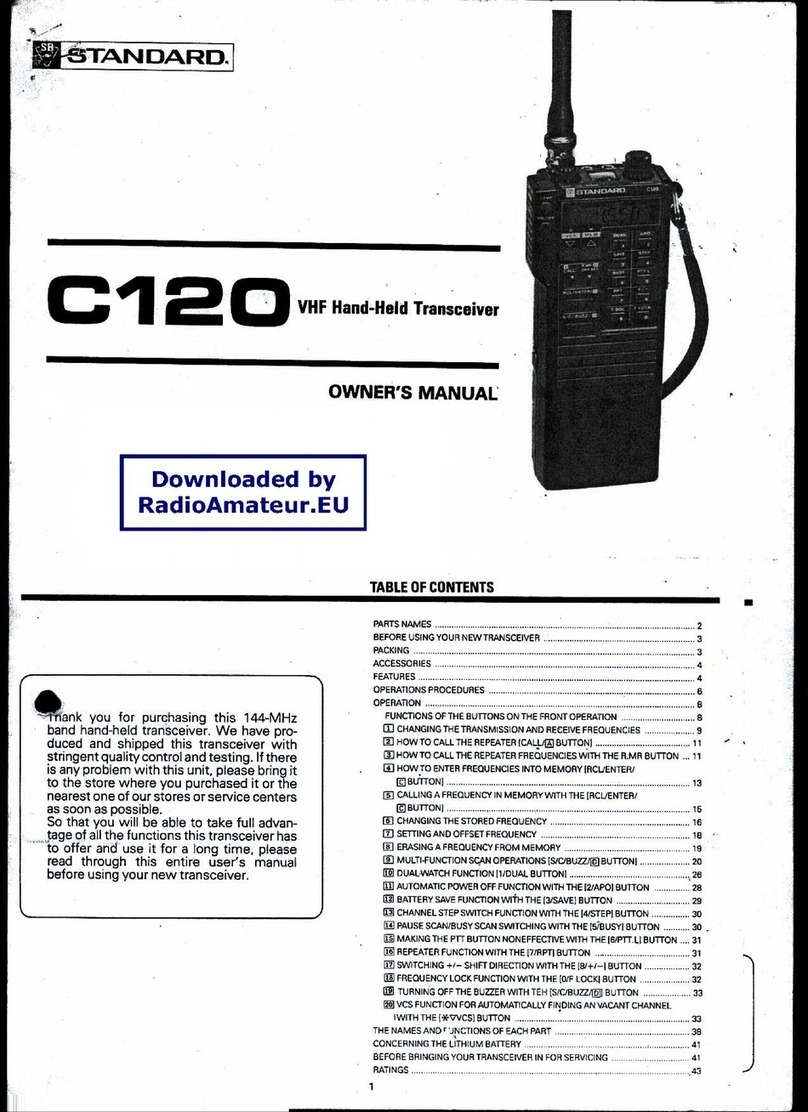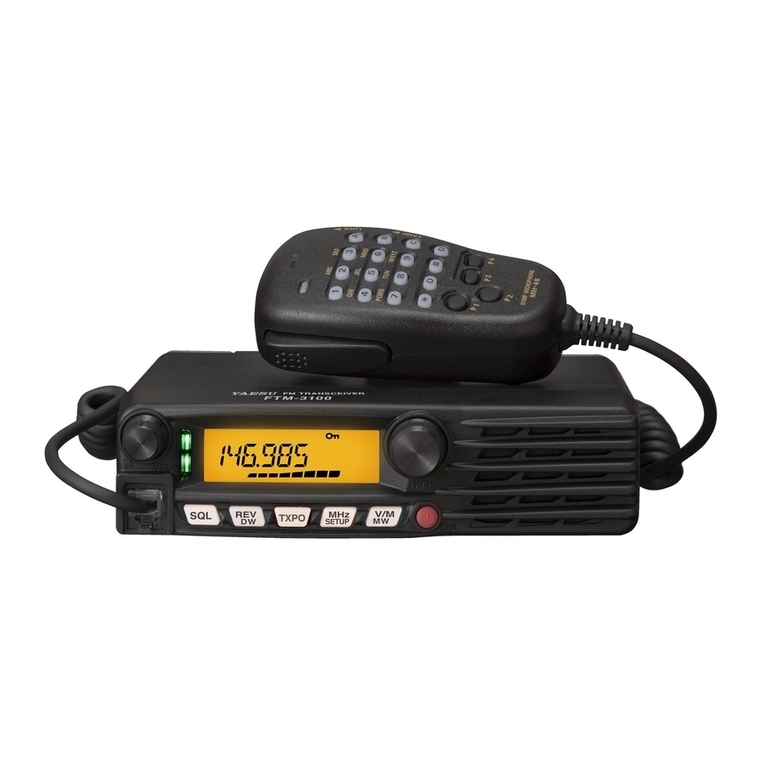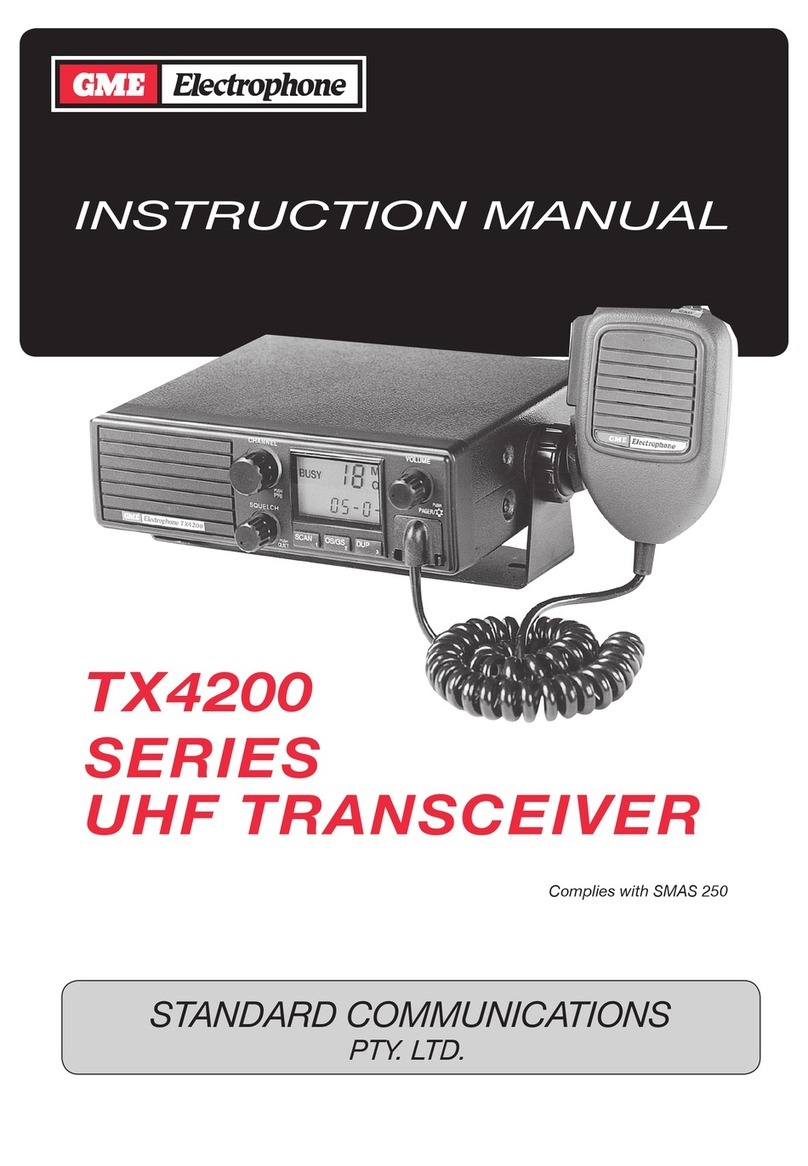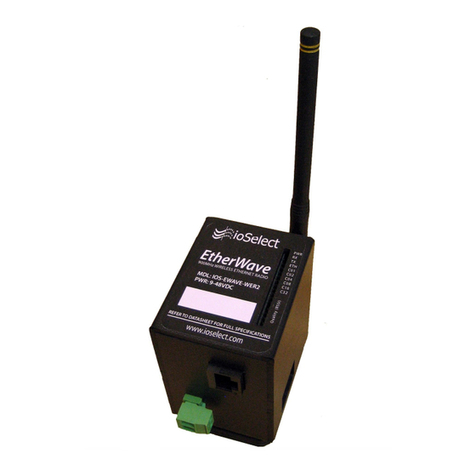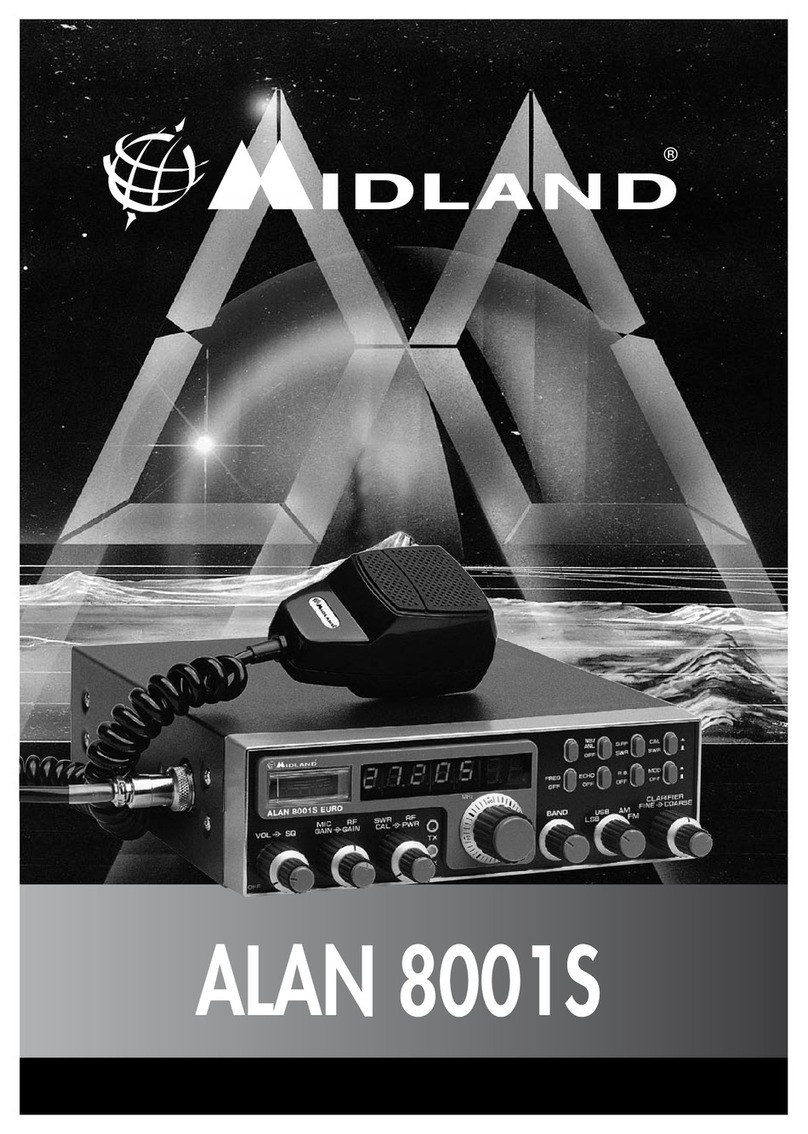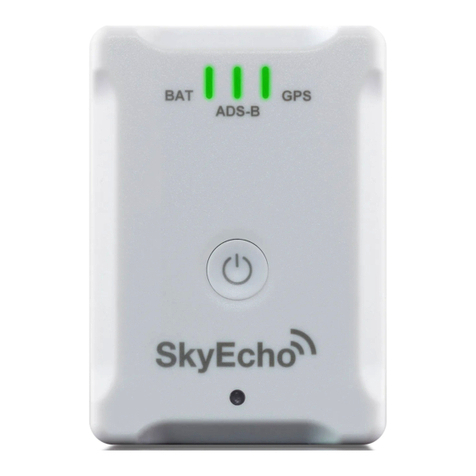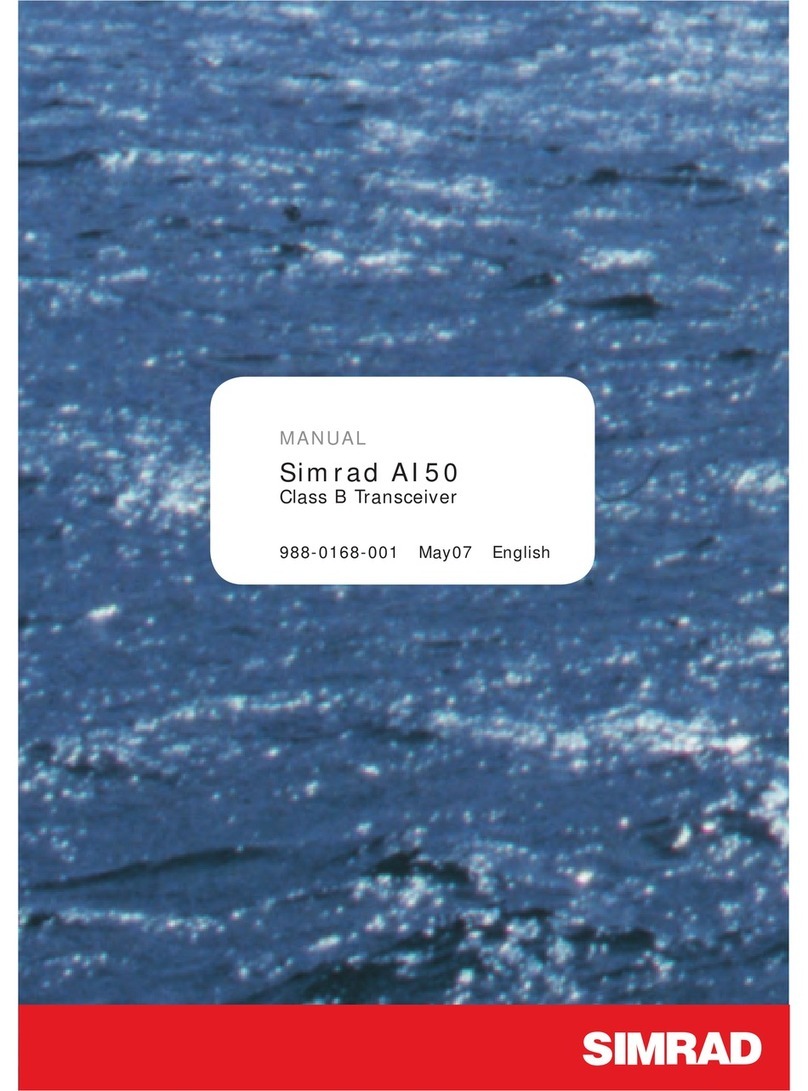Icom IC-910H User manual

INSTRUCTION MANUAL
VHF/UHF
ALL MODE TRANSCEIVER
i910H

IMPORTANT
READ THIS INSTRUCTION MANUAL CARE-
FULLY before attempting to operate the transceiver.
SAVE THIS INSTRUCTION MANUAL. This
manual contains important safety and operating in-
structions for the IC-910H.
EXPLICIT DEFINITIONS
i
RWARNING HIGH VOLTAGE! NEVER at-
tach an antenna or internal antenna connector during
transmission. This may result in an electrical shock or
burn.
RNEVER apply AC to the [DC13.8V] jack on the
transceiver rear panel. This could cause a fire or ruin
the transceiver.
RNEVER apply more than 16 V DC, such as a 24
V battery, to the [DC13.8V] jack on the transceiver rear
panel. This could cause a fire or ruin the transceiver.
RNEVER let metal, wire or other objects touch any
internal part or connectors on the rear panel of the
transceiver. This may result in an electric shock.
RNEVER expose the transceiver to rain, snow or
any liquids.
AVOID using or placing the transceiver in areas with
temperatures below –10°C (+14°F) or above +60°C
(+140°F). Be aware that temperatures on a vehicle’s
dashboard can exceed 80°C (+176°F), resulting in
permanent damage to the transceiver if left there for
extended periods.
AVOID placing the transceiver in excessively dusty en-
vironments or in direct sunlight.
AVOID placing the transceiver against walls or putting
anything on top of the transceiver. This will obstruct
heat dissipation.
Place unit in a secure place to avoid inadvertent use
by children.
During mobile operation, DO NOT operate the trans-
ceiver without running the vehicle’s engine. When the
transceiver power is ON and your vehicle’s engine is
OFF, the vehicle’s battery will soon become exhaust-
ed.
Make sure the transceiver power is OFF before start-
ing the vehicle. This will avoid possible damage to the
transceiver by ignition voltage spikes.
During maritime mobile operation, keep the transceiv-
er and microphone as far away as possible from the
magnetic navigation compass to prevent erroneous in-
dications.
BE CAREFUL! The heatsink will become hot when op-
erating the transceiver continuously for long periods.
BE CAREFUL! If a linear amplifier is connected, set
the transceiver’s RF output power to less than the lin-
ear amplifier’s maximum input level, otherwise, the lin-
ear amplifier will be damaged.
Use Icom microphones only (supplied or optional).
Other manufacturer’s microphones have different pin
assignments, and connection to the IC-910H may
damage the transceiver.
PRECAUTIONS
WORD
R
WARNING
CAUTION
NOTE
DEFINITION
Personal injury, fire hazard or electric
shock may occur.
If disregarded, inconvenience only.
No risk of personal injury, fire or
electric shock.
Equipment damage may occur.

SUPPLIED ACCESSORIES
The transceiver comes with the following accesso-
ries.
Qty.
q DC power cable (OPC-657A) ............................ 1
w Hand microphone (HM-36) ............................... 1
e Spare fuses (FGB 30 A) .................................... 2
r Spare fuse (FGB 4 A) ....................................... 1
1
1
TABLE OF CONTENTS
qwe
r
IMPORTANT ........................................ i
EXPLICIT DEFINITIONS ..................... i
PRECAUTIONS ................................... i
1 TABLE OF CONTENTS ................ 1
2 PANEL DESCRIPTION ......... 2 – 13
nFront panel ..................................... 2
nFunction display ........................... 10
nRear panel .................................... 12
3 INSTALLATION AND
CONNECTIONS .................. 14 – 17
nUnpacking .................................... 14
nGrounding .................................... 14
nSelecting a location ...................... 14
nAntenna connection ..................... 14
nRequired connections .................. 15
nAdvanced connections ................. 16
nPower supply connections ............ 17
4 BASIC OPERATION ........... 18 – 25
nInitial settings ............................... 18
nWhen first applying power
(CPU resetting) ............................ 18
nMAIN and SUB bands .................. 19
nOperating band selection ............. 20
nVFO description ........................... 21
nFrequency setting ......................... 22
nSUB band OFF ............................. 24
nSUB tuning dial ............................ 24
nDial lock function .......................... 25
5 RECEIVE AND TRANSMIT 26 – 39
nFunctions for receive .................... 26
nRIT function .................................. 27
nIF shift function ............................. 27
nAGC time constant ....................... 28
nAFC function ................................ 28
nFM center indicator ...................... 28
nAttenuator ..................................... 29
nSimple band scope ....................... 29
nNoise blanker ............................... 30
nTone squelch operation ................ 30
nOptional DSP functions ................ 31
nFunctions for transmit ................... 32
nTransmit via microphone .............. 32
nIndications during transmit ........... 32
nFM mode operation ...................... 33
nVOX operation .............................. 33
nRepeater operation ...................... 34
nSSB mode operation .................... 36
nSpeech compressor ..................... 36
nSplit frequency operation ............. 37
nFull duplex operation .................... 37
nConnections for CW ..................... 38
nCW mode operation ..................... 38
6 MEMORY OPERATION ...... 40 – 44
nMemory channels ......................... 40
nOperation on a memory channel .. 40
nProgramming in VFO mode .......... 41
nProgramming in memory mode .... 41
nBlank channels ............................. 42
nFrequency transferring ................. 42
nMemory clearing .......................... 43
nCall channels ................................ 43
nMemo pads .................................. 44
7 SCANS ................................ 45 – 47
nScan types ................................... 45
nPreparation ................................... 45
nProgrammed scan operation ........ 46
nMemory scan operation ............... 46
nMemory select scan ..................... 47
nTone scan ..................................... 47
8 SATELLITE OPERATION ... 48 – 51
nSatellite communications outline .. 48
nSatellite notes ............................... 48
nEntering into the satellite mode .... 48
nSetting the satellite VFO ............... 49
nTracking selection ......................... 49
nPreparation ................................... 50
nSatellite operation ........................ 51
nSatellite memory .......................... 51
9 DATA COMMUNICATION ... 52 – 54
nFunctions for AFSK ...................... 52
nConnections for AFSK .................. 52
nOperating mode notes .................. 53
nOperating frequency notes ........... 53
nAFSK operation ............................ 53
nSetting the ACC socket ................ 54
10 SET MODE ......................... 55 – 69
nSet mode description ................... 55
nGeneral set mode ......................... 56
nFM set mode ................................ 60
nSSB/CW set mode ....................... 62
nScan set mode ............................. 64
nMemo pad set mode .................... 64
nCompressor set mode .................. 64
nVOX set mode .............................. 65
nAttenuator set mode ..................... 65
nTransmit set mode ........................ 66
nNR set mode ................................ 67
nSWP set mode ............................. 67
nRIT/SHIFT set mode .................... 68
nSpeech set mode ......................... 69
11 OPTION INSTALLATIONS . 70 – 76
nInternal view ................................. 70
nOpening the transceiver’s case .... 71
nUT-102 VOICE SYNTHESIZER
UNIT .............................................. 71
nUT-106 DSP UNIT .......................... 72
nUX-910 1200 MHz BAND UNIT ........ 73
nCR-293 HIGH STABILITY CRYSTAL
UNIT .............................................. 74
nFL-132/FL-133 CW NARROW
FILTER ........................................... 75
12 MAINTENANCE .................. 76 – 77
nTroubleshooting ............................ 76
nFuse replacement ........................ 77
nCPU resetting ............................... 77
13 CONTROL COMMAND ...... 78 – 79
nRemote jack (CI-V) information .... 78
14 SPECIFICATIONS ...................... 80
15 OPTIONS .................................... 81
16 INSTALLATION NOTES ..... 82 – 83

nFront panel
qPOWER SWITCH [POWER]
➥Push momentarily to turn power ON.
➥Push for 2 sec. to turn power OFF.
wTRANSMIT SWITCH [TRANSMIT]
Push to select transmitting or receiving.
eCOMPRESSION SWITCH [COMP] (p. 36)
Push to switch the speech compressor function ON
and OFF.
•
The speech compressor increases average RF output
power, improving signal strength and readability in SSB.
rVOX SWITCH [VOX] (p. 33)
Push to switch the VOX function ON and OFF.
•TheVOX(Voice-OperatedTransmission)functiontog-
gles between transmit and receive with your voice. This
function provides an opportunity to input log entries into
your computer, etc., while operating.
tHEADPHONE JACK [PHONES]
Accepts headphones.
•Outputpower:5mWwith8–16Ωload.
•Whenheadphonesareconnected,theinternalspeaker
or connected external speaker does not function.
•TheMAINandSUBbandaudiocanbemixedorsepa-
rated when using stereo headphones according to set
mode settings. (p. 57)
yMICROPHONE CONNECTOR [MIC]
Accepts the supplied or optional microphone.
•Seep.81forappropriatemicrophones.
•Seep.15formicrophoneconnectorinformation.
uMIC GAIN CONTROL [MIC GAIN]
Adjusts microphone input gain.
MIC GAIN
Recommended level for
an Icom microphone
IncreasesDecreases
How to set the microphone gain.
Set the [MIC] control so that the [MAIN]/[SUB] indicator (ALC
indicator) some times lights brighter during normal voice
transmission in SSB mode.
iRF POWER CONTROL [RF PWR]
Continuously varies the RF output power from min-
imum to maximum.
144 MHz band 5–100 W
430(440) MHz band 5–75 W
1200 MHz band 1–10 W (optional UX-910)
RF PWR
IncreasesDecreases
2
2
PANEL DESCRIPTION
q
o!0 !1 !2 !3
w
e
r
t
y
u
i

oMAIN BAND INDICATOR [MAIN]
➥Lights green while the squelch is opened or a
signal is received on the MAIN band; lights red
while transmitting on the MAIN band.
•Whiletransmitting,theindicatoralsoshowsALCcon-
dition. Brightness increases more than usual when
the ALC function is activated.
➥
Flashes when an off-frequency signal is received
and the FM center detector is activated. (p. 28)
!0 RF GAIN CONTROL/SQUELCH CONTROL
[RF/SQL] (outer control)
Adjusts the RF gain and squelch threshold level for
the MAIN band. The squelch removes noise output
from the speaker (closed condition) when no signal
is received.
•ThesquelchisparticularlyeffectiveforFM.Itisalso
available for other modes.
•12to13o’clockpositionisrecommendedforanysetting
of the [RF/SQL] control.
•ThesquelchthresholdpositionforSSB/CWmodecan
be set from 12 or 13 o’clock position in SSB/CW set
mode. (p. 62)
•
The control can be set as ‘Auto’ (RF gain control in SSB
and CW; squelch control in FM) or squelch control (RF
gain is fixed at maximum) in set mode as follows. (p. 56)
MODE
SSB, CW
FM
AUTO
RF GAIN
SQL
SQL
SET MODE SETTING
SQL
SQL
RF GAIN + SQL
RF GAIN + SQL
SQL
• When setting as RF gain/squelch control
Recommended level
RF gain
adjustable
range (SSB,
CW modes)
Maximum
RF gain
S-meter
squelch
Noise squelch (FM mode)
Squelch is
open.
• When functioning as RF gain control
(Squelch is fixed open; SSB, CW only)
Minimum RF gain
Adjustable
range
Maximum
RF gain
• When functioning as squelch control
(RF gain is fixed at maximum.)
Squelch is
open.
S-meter
squelch
S-meter squelch
threshold
Noise squelch
threshold
Shallow Deep
Noise squelch
!1 AF CONTROL [AF] (inner control)
Varies the audio output level from the speaker for
the MAIN band.
AF RF/SQL
No audio output Max. audio output
Decreases Increases
!2 SUB BAND INDICATOR [SUB]
Lights green while the squelch is opened or a sig-
nal is received on the SUB band; lights red while
transmitting in satellite operation.
!3 RF GAIN CONTROL/SQUELCH CONTROL
[RF/SQL] (outer control)
Adjusts the RF gain and squelch threshold level for
the SUB band. The squelch removes noise output
from the speaker (closed condition) when no signal
is received.
3
2
PANEL DESCRIPTION

4
2PANEL DESCRIPTION
nFront panel (continued)
!4 AF CONTROL [AF] (inner control)
Varies the audio output level from the speaker for
the SUB band.
!5 SET•MENU SWITCH [SET•MENU] (p. 55)
➥Push this switch then one of [FM],
[SSB/CW], [RIT], [SCAN], [NR], [TRANS-
MIT], [COMP], [VOX], [ATT], [SWP],
[MPW] or [SPCH] to enter the indepen-
dent item set mode.
For 1 sec.
➥Push for 1 sec. to enter the set mode for
commonly used item settings.
!6 ATTENUATOR•PRE-AMP SWITCH [ATT•P.AMP]
➥Push to switch the attenuator function
ON and OFF. (p. 29) Use this function to
protect from signal distortion from exces-
sively strong signals.
•Theattenuationlevelisindependentlyad-
justable for 144 MHz or 430(440) MHz band
in the ATT set mode. The optional 1200 MHz
band attenuation level is fixed and is approx.
20 dB. (p. 65)
For 1 sec.
➥
Push for 1 sec. to switch the connected
pre-amplifier ON and OFF, when an op-
tional pre-amplifier unit, AG-25, AG-35
and/or AG-1200, is connected. (p. 16)
DO NOT connect any equipment, such as an SWR
or power meter between the transceiver and pream-
plifier. In such case, the preamplifier may not acti-
vate properly.
!7 AUTO FREQUENCY CONTROL/NOISE
BLANKER•NOISE REDUCTION SWITCH
[AFC/NB•NR]
➥During FM/FM narrow mode operation,
push to switch the AFC (Automatic Fre-
quency Control) function ON and OFF.
(p. 28)
•Automaticallytunestheoperatingfrequency,
when an off-frequency signal is received, in
100 kHz steps. This function also follows the
signal even if the frequency is shifted.
➥During SSB or CW mode operation,
push to switch the noise blanker function
ON and OFF. (p. 30)
•Reducespulse-typenoise,suchasignition
noise from a vehicle.
For 1 sec.
➥Push for 1 sec. to switch the noise reduc-
tion function ON and OFF when an op-
tional DSP unit, UT-106, is installed.
(p. 31)
•Reducesunwantednoiseandpullsoutthe
desired signal only for clear readability.
!4 !5 !6 !7 !8 !9 @0
@
1@2 @3

5
2
PANEL DESCRIPTION
!8 AUTO GAIN CONTROL•AUTO NOTCH FILTER
SWITCH [AGC•ANF]
➥Push to switch the time constant of the
automatic gain control to SLOW and
FAST for the MAIN band.* (p. 28)
•SLOWselection(“FAGC”disappears)during
SSB (USB or LSB) operation, FAST selec-
tion(“FAGC”appears)duringCW,dataop-
eration and while tuning with fast tuning dial
rotation are recommended.
*The AGC time constant can be selected on
the MAIN band only. FAST selection is fixed
on the SUB band.
For 1 sec.
➥Push for 1 sec. to switch the automatic
notch filter function ON and OFF when
the optional DSP unit, UT-106, is in-
stalled. (p. 31)
•
Reduces interference signals such as beat,
RTTY or CW signals and the notch frequency
automatically follows the interfering signal.
!9 kHz/MHz•TUNING STEP SELECTION SWITCH
[kHz/MHz] (p. 22)
➥Push to select tuning step for the tuning
dial or scanning from 1 kHz, 1 MHz step
and regular tuning step* in sequence
•“Z”appearsabovethe1kHzor1MHzdigit
when 1 kHz or 1 MHz tuning step is select-
ed, respectively.
*The regular tuning step is selected for each
operating mode as follows.
For 1 sec.
➥Push for 1 sec. to enter the regular tun-
ing step selection mode.
•Thetuningstepcanbeselectedforeachop-
erating mode independently.
•SSB/CWmode:1,10,50and100Hzstep;
FMmode:0.1,5,6.25,10,12.5,20,25and
100 kHz step can be selected by rotating the
tuning dial.
@0 SPEECH•LOCK SWITCH [SPCH•LOCK]
➥Announces the receiving signal strength
and/or selected readout frequency when
the optional UT-102 is installed. (pgs. 69,
71)
For 1 sec.
➥Push for 1 sec. to switch the tuning dial
lock function ON and OFF to prevent ac-
cidental setting changes. (p. 25)
@1 TUNING DIAL
Changes the displayed frequency, selects set mode
items, etc.
@2 BRAKE ADJUSTMENT SCREW
Adjust the tension of the tuning dial.
•Rotateclockwisetoincreasethetension;counterclock-
wise to decrease the tension.
Brake adjustment screw
@3 MEMORY CHANNEL UP/DOWN SWITCHES
[YUP]/[DOWN Z](p. 40)
or
➥Push [YUP] to change the memory
channel up; push [DOWN Z] to change
the memory channel down.
•Memorychannelchangescontinuouslywhile
holding either switch.
•Memorychannelscanbeselectedbothin
VFO and memory modes.
For 1 sec.
or

6
2PANEL DESCRIPTION
@4 RIT CONTROL [RIT] (p. 27)
Shifts the receive frequency without changing the
transmit frequency for the MAIN band only while
the RIT function is activated.
•SSB/CWmode :±1.0kHz*in10Hzstep
•FMmode :±5.0kHz*in50Hzstep
*For1200MHzband;±2.0kHzand±10.0kHz,respec-
tively when the optional UX-910 is installed.
•ByusingtheSubdialfunction,theRITcontrolcanbe
used as the MAIN/SUB tuning dial or the SUB band IF
shift control. See page 24 for details.
@5 IF SHIFT CONTROL [SHIFT]
Shifts the center frequency of the receiver’s IF pass-
band within 1.2 kHz range.
•ByusingtheSubdialfunction,theIFshiftcontrolcan
be used as the MAIN/SUB tuning dial or the SUB band
IF shift control. See page 24 for details.
What is the Sub dial function?
The [RIT] and [SHIFT] controls are used for RIT and IF shift
controls for the MAIN band by default. However, the Sub dial
function assigns these controls as the MAIN/SUB tuning dial
or the SUB band IF shift control. (p. 24, 68)
RIT S
H
IFT RIT S
H
IFT RIT S
H
IFT
Center positionMax. counter-
clockwise position
Max. clockwise
position
@6 SATELLITE SWITCH [SATELLITE]
➥Push to enter satellite mode (RX on
MAIN, TX on SUB band). Push again to
return to the condition before entering
into the satellite mode.
For 1 sec.
➥Push to enter satellite mode using the
current operating frequencies when
pushing for 1 sec.
For 1 sec.
•Tochangethenormalandreversesatellite
operations, push [F-INP/ENT] for 1 sec.
@7 RIT SWITCH [RIT] (p. 27)
➥Push to switch the RIT control activity
ON and OFF.
•“RIT”indicatorappearswhentheRITfunc-
tion is in use.
For 1 sec.
➥Push for 1 sec. to switch the Sub dial
function ON and OFF.
•“RIT” indicator flashes and the [RIT] and
[SHIFT] controllers acts as the controllers
specified in the RIT/SHIFT set mode. (p. 68)
@8 KEYPAD
Numeral and other function keys for tuning and ac-
tivating functions.
See the table at right.
nFront panel (continued)
@4
@5
@6
@8
@7

7
2
PANEL DESCRIPTION
•Entersnumeral“1”whenenteringanoperating
frequency. (p. 23)
•Switches betweenVFO and memory mode.
(p. 40)
Entersnumeral“2”whenenteringanoperating
frequency. (p. 23)
•Entersnumeral“3”whenenteringanoperating
frequency. (p. 23)
•SwitchesbetweenVFOA and B duringVFO
mode operation. (p. 21)
Entersnumeral“4”whenenteringanoperating
frequency. (p. 23)
Entersnumeral“5”whenenteringanoperating
frequency. (p. 23)
Entersnumeral“6”whenenteringanoperating
frequency. (p. 23)
Entersnumeral“7”whenenteringanoperating
frequency. (p. 23)
•Entersnumeral“8”whenenteringanoperating
frequency. (p. 23)
•Storesthedisplayedoperatingconditionsinto
MEMO PAD channel (p. 44)
•Entersnumeral“9”whenenteringanoperating
frequency. (p. 23)
•Re-callsthecontentsintheMEMOPADchan-
nel. (p. 44)
•Entersdecimalpoint“.”forenteringbelowthe
“MHz“digitswhen enteringanoperatingfre-
quency.
•Startsandcancelsscanningfunction.(p.46)
•TurnsOFFtheSUBbandfrequencyindication
during satellite operation. In this case, only the
MAIN band frequency can be tuned by rotating
the tuning dial. (p. 49)
•Entersnumeral“0”whenenteringanoperating
frequency. (p. 23)
•SwitchessweepfunctionforthebandscopeON
and OFF. (p. 29)
•TurnsOFFtheMAINbandfrequencyindication
during satellite operation. In this case, only the
SUB band frequency can be tuned by rotating
the tuning dial. (p. 49)
Enables operating frequency entering from the
keypad. See page 23 for details.
Equalizes the condition of the VFO A and B.
(p. 21)
Shows 10 Hz and 1 Hz digits of operating fre-
quency on both the MAIN and SUB bands while
pushing and holding. (p. 22)
Stores the set conditions into a memory channel.
(p. 41)
Clears stored contents of memory channel to be a
blank channel. (p. 43)
Transfers the contents of a memory channel into
either the VFO A or B. (p. 42)
Opens squelch for monitoring the operating or
transmit frequency, and the frequency indication
automatically changes to transmit frequency in
the case of duplex or split operation. (p. 34)
Starts and cancels tone scan when the repeater
tone or tone squelch is activated in FM (narrow)
operation. (p. 47)
Used to change memory channel during memo-
ry mode operation by rotating the tuning dial while
pushing and holding. (p. 40)
Switch Switch action when pushed Switch action when pushed for 1 sec.

8
2PANEL DESCRIPTION
@9 SPLIT•DUPLEX SWITCH [SPLIT•DUP]
➥Push to turn the split function, with the
VFO A and B, ON and OFF. (p. 37)
•Thesplitoperationis notavailableforthe
SUB band.
For 1 sec.
➥Push for 1 sec. to select the duplex (re-
peater) direction or to turn the function
OFF. (p. 34)
•Theduplexoperationisnotavailableforthe
SUB band.
#0 SSB/CW•CW-NARROW SWITCH
[SSB/CW•CW-N]
➥Push to switch the operating mode be-
tween SSB and CW. (p. 23)
For 1 sec.
➥Push for 1 sec. to switch the operating
mode between USB and LSB or be-
tween CW and CW narrow during SSB
or CW mode, respectively.
#1 FM•FM-NARROW SWITCH [FM•FM-N] (p. 23)
➥Push to switch the operating mode be-
tween FM and FM repeater mode.
•The duplex operation can be made in
MAIN band only, it cannot be operated in
SUB band.
For 1 sec.
➥Push for 1 sec. to switch the operating
mode between FM and FM-N (FM nar-
row).
•The FM-N mode cannot be selected in
1200 MHz band operation.
#2 TONE SWITCH [TONE] (p. 34)
➥Push to turn the tone encoder function
ON and OFF in FM mode. (except Eu-
rope, Sweden and Italy versions)
•“T”indicatorappearsinthedisplaywhenthe
tone encoder is activated.
➥Push to transmit a 1750 Hz repeater
tone in FM mode for European, Sweden
and Italy versions.
Available repeater tones (Unit:Hz)
#3 MAIN/SUB CHANGE•BAND SWITCH
[M/S•BAND]
➥Push to replace the MAIN band’s fre-
quency and mode with the SUB band’s.
(p. 19)
For 1 sec.
➥Push for 1 sec. to change the operating
band during single band operation or
when the optional band unit, UX-910, is
installed. (p. 20)
#5 #4 #3 #2 #1 #0 @9
67.0
69.3
71.9
74.4
77.0
79.7
82.5
085.4
088.5
091.5
094.8
097.4
100.0
103.5
107.2
110.9
114.8
118.8
123.0
127.3
131.8
136.5
141.3
146.2
151.4
156.7
159.8
162.2
165.5
167.9
171.3
173.8
177.3
179.9
183.5
186.2
189.9
192.8
196.6
199.5
203.5
206.5
210.7
218.1
225.7
229.1
233.6
241.8
250.3
254.1
nFront panel (continued)

9
2
PANEL DESCRIPTION
#4 SUB•SUB OFF SWITCH [SUB•SUB OFF]
➥Push to enable the SUB band control
from the tuning dial, keypad, etc. (p. 19)
•“SUB”indicatorappears.
For 1 sec.
➥Push for 1 sec. to turn the SUB band
readout indication ON and OFF. (p. 24)
#5 CALL•TONE SQUELCH SWITCH [CALL•T-SQL]
➥Push to select the call channel of the op-
erating band. The call channel can be
selected from both the VFO and memory
mode operation. (p. 43)
For 1 sec.
➥Push for 1 sec. to turn the tone squelch
function ON and OFF during FM mode
operation. (p. 30)
•“T-SQL” indicator appears when the tone
squelch is activated.

10
2PANEL DESCRIPTION
qFREQUENCY READOUTS (p. 22)
Shows the operating frequency.
•Settingitemnameisindicatedduringsetmode.(p.55)
wMODE INDICATOR (p. 23)
Shows the selected operation mode.
eTUNING STEP INDICATOR (p. 22)
Appears when the 1 kHz or 1 MHz tuning step is
selected.
rDUPLEX INDICATOR (p. 34)
Either“DUP–”or“DUP+”appearsduringduplex(re-
peater) operation.
tSPLIT INDICATOR (p. 37)
Appears during split operation.
yRIT INDICATOR (p. 27)
➥Appears while the RIT function is activated.
➥Flashes while the SUB dial function is activated.
uVFO INDICATOR (p. 21)
Either VFO A or VFO B appears during VFO opera-
tion.
iMEMORY MODE INDICATORS/MEMORY
CHANNEL NUMBER READOUTS (p. 40)
The memory mode indicator appears during mem-
ory mode operation and the memory channel num-
ber readout shows the selected memory channel
number during both the memory and VFO mode
operation.
Memory channel number readout
In addition to the memory channel number indication, the
memory channel number readout indicates 10 Hz and 1 Hz
digits of operating frequency while rotating the tuning dial in
SSB or CW mode with 10 or 1 Hz tuning step. After 2 sec.
from tuning dial operation, the readout indicates the memo-
ry channel number.
oAUTO NOTCH FILTER INDICATOR (p. 31)
Appears when the optional DSP unit, UT-106, is in-
stalled, and the ANF (Automatic Notch Filter) func-
tion is activated.
!0 BLANK INDICATOR (p. 42)
Appears when the selected memory channel has
not been programmed or has been cleared.
VF
O
A
VF
O
B
M
E
MO
R
I TC W N
L
SB
U
SB
N
F
M
S
U
B
NOR
S
A
T
L
RE
V
L
OCK
T-SQ
L
S1357920 40 60dB
ATT P.AMPAFCNB FAGCNR ANF
BL
A
NK
S
W
P
S
C
A
N
OVER
MEMO
F
M
N
USBLSB
C
W
N
RIT
SPLIT VFO A
VFO B
S
E
T
BL
AN
K
T-SQ
L
A
TT P.AMP AFCN
BF
AGC
N
R
ANF
9600
COMP
S
W
P
60dB
V
O
X
S
C
A
N
OVER
S13 5 7920 40
DUP
q
q
w
w
e
e
rty
y
u
u
i
i
o
o
!0
!0
!1
!2
!3!4
!5
!5
!6
!6
!7
!7
!8
!8
!9
!9
@0
@0
@1
@1
@2
@2
@3
@3
@5
@6
@7
@8
@4
@4
n Function display

11
2
PANEL DESCRIPTION
!1 DATA TRANSMISSION SPEED INDICATOR
(p. 52)
Appears when 9600 bps speed is selected for pack-
et transmission.
!2 SPEECH COMPRESSOR INDICATOR (p. 36)
Appears when the speech compressor is activated.
!3 SET INDICATOR (p. 55)
Appears when [SET] is pushed.
Disappears after any switch is pushed.
!4 VOX INDICATOR (p. 33)
Appears when the VOX function is activated.
!5 SWEEP INDICATOR (p. 29)
Flashes while the simple bandscope function is ac-
tivated.
!6 SCAN INDICATOR (p. 46)
Flashes while scanning.
!7 NOISE REDUCTION INDICATOR (p. 31)
Appears when the optional DSP unit, UT-106, is in-
stalled and the noise reduction is activated.
!8 AGC TIME CONSTANT INDICATOR (p. 28)
Appears when the FAST AGC time constant is se-
lected; disappears when the SLOW AGC time con-
stant is selected.
!9 NOISE BLANKER INDICATOR (p. 30)
Appears when the noise blanker function is activat-
ed.
@0 AUTO FREQUENCY CONTROL INDICATOR
(p. 28)
Appears when the AFC (Automatic Frequency Con-
trol) function is activated.
@1 PRE-AMP INDICATOR (p. 16)
Appears when the optional pre-amplifier unit, AG-
25, AG-35 and/or AG-1200, is connected and the
pre-amplifier function is activated.
@2 ATTENUATOR INDICATOR (p. 29)
Appears when the attenuator is activated.
@3 MULTI-FUNCTION BAR METER
➥Shows the receiving signal strength as an S-me-
ter while receiving. Peak hold function is avail-
able and can be switched ON and OFF in regular
set mode. (pgs. 26, 56)
➥Shows the relative transmit output power level as
an RF power indicator during transmit. (p. 32)
➥Shows signal availability in the sweeping band,
andthe“Z”indicatorindicatesthecenterofthe
sweeping frequency band.
@4 TONE SQUELCH INDICATOR (pgs. 30, 34)
“T”appearswhenthetoneencoderfunctionisacti-
vated;“T-SQL”appearswhenthetonesquelchfunc-
tion is activated.
@5 SUB INDICATOR (p. 19)
Appears when the SUB band access is enabled.
@6 SATELLITE INDICATOR (p. 49)
Appears while satellite operation mode is selected.
• SATL -NOR :Satelliteoperationwithnormalmode
is selected.
• SATL -REV :Satelliteoperationwithreversemode
is selected.
@7 REMOTE INDICATOR (p. 78)
Appears when the transceiver is controlled remote-
ly via the optional CI-V level converter, CT-17.
@8 LOCK INDICATOR (p. 25)
Appears when the dial lock function is activated.

12
2PANEL DESCRIPTION
nRear panel
q 430(440) MHz ANTENNA CONNECTOR (p. 15)
Accepts a 50 Ωantenna with a type-N connector.
wDC POWER SOCKET [DC 13.8V] (p. 17)
Accepts 13.8 V DC through the supplied DC power
cable (OPC-657A).
Rear panel
view +_
e144 MHz ANTENNA CONNECTOR (p. 15)
Accept a 50 Ωantenna with a PL-259 connector.
rSUB BAND EXTERNAL SPEAKER JACK
[SP (SUB)]
tMAIN BAND EXTERNAL SPEAKER JACK
[SP (MAIN)] (p. 16)
Accepts a 4–8 Ωspeaker.
By connecting an external speaker for each or both
jacks, the audio for both the MAIN and SUB bands
is output as follows.
y1200 MHz ANTENNA CONNECTOR (p. 15)
Available when the optional 1200 MHz band unit
is installed. Accepts a 50 Ωantenna with a type-N
connector.
uKEY JACK [KEY] (p. 15)
Accepts a paddle, a straight key or external elec-
tronic keyer with 1⁄8inch standard plug.
(+)
(_)
(dot)
(com)
(dash)
i SUB BAND DATA SOCKET [DATA (SUB)]
o MAIN BAND DATA SOCKET [DATA (MAIN)]
(p. 13)
6-pin mini plug DIN jack to connect a TNC, etc. for
high speed data communications.
Independent data sockets enable simultaneous re-
ception in both MAIN and SUB bands for data com-
munication.
(MAINband:TX/RX,SUBband:RXonly)
!0 ACCESSORY SOCKET [ACC(1)]
Enables connection of external equipment such as
a TNC for data communications, etc.
•Seetherighttableforsocketinformation.
!1 CI-V REMOTE CONTROL JACK [REMOTE]
(p. 78)
Designed for use with a personal computer via the
optional CT-17 for remote control of transceiver
functions.
!2 GROUND TERMINAL [GND] (p 14)
Connect this terminal to a ground to prevent electri-
cal shocks and other problems.
o
!2
we
rt
y
u
i
q
!0
!1
MAIN AF SUB AF
No Int. SP Int. SP
SP (MAIN) Ext. SP Ext. SP
SP (SUB) Int. SP Ext. SP
Both Ext. SP (MAIN) Ext. SP (SUB)

13
2
PANEL DESCRIPTION
DACC SOCKETS
DDATA SOCKETS
oMAIN BAND DATA SOCKET
DATA Socket Pin No. Pin Name Description
1
2
3
4
5
6
DATA IN
GND
PTTP
DATA
OUT
AF OUT
SQL
Input terminal for data (common for both 1200 and 9600 bps)
Ground line for the DATA IN, DATA OUT and AF OUT.
Transmits when this terminal is grounded.
Received data output terminal for 9600 bps operation.
Received data output terminal for 1200 bps operation.
Output terminal for squelch condition (Open/Close). Outputs grounded level signal
when squelch is opened, +8 V level signal when squelch is closed.
qw
e
y
t
r
ACC(1) Socket Pin No. Pin Name Description Specication
1
2
3
4
5
6
7
8
NC
GND
SEND
MOD
AF
SQLS
13.8 V
ALC
No connection.
Connect to ground.
Input terminal to transmit the trans-
ceiver in relation to the external equip-
ment.(Grounded:transmits)
Input terminal for the modulation cir-
cuit.
Output terminal for AF signals from
the AF detector circuit. Output level is
fixed, regardless of [AF] control.
Output terminal for squelch condition
(Open/Close). Outputs grounded level
signal when squelch is opened.
Output terminal for 13.8 V DC, in rela-
tion to the [POWER].
Input terminal for ALC control.
Transmitvoltage :–0.5to+0.8V
Outputcurrent :Lessthan20mA
Inputcurrent(Tx) :Lessthan200mA
Outputimpedance :10kΩ
Inputlevel :100mVrms
Outputimpedance :4.7kΩ
Outputlevel :100–300mVrms
Squelchopen :Lessthan0.3V/5mA
Squelchclose :Morethan6.0V/100µA
Outputcurrent :Lessthan1A
Inputimpedance :Morethan10kΩ
Controlvoltage :–4to0V
1
2
3
45
67
8
DATA Socket Pin No. Pin Name Description
1
2
3
4
5
6
NC
GND
NC
DATA
OUT
AF OUT
SQL
No connection.
Ground line for the DATA OUT and AF OUT.
No connection.
Received data output terminal for 9600 bps operation.
Received data output terminal for 1200 bps operation.
Output terminal for squelch condition (Open/Close). Outputs grounded level signal
when squelch is opened, +8 V level signal when squelch is closed.
qw
e
y
t
r
iSUB BAND DATA SOCKET

3
14
INSTALLATION AND CONNECTIONS
n Unpacking
After unpacking, immediately report any damage to the
delivering carrier or dealer. Keep the shipping cartons.
For a description and a diagram of accessory equip-
ment included with the IC-910H, see ‘Supplied acces-
sories’ on p. 1 of this manual.
n Grounding
To prevent electrical shock, television interference
(TVI), broadcast interference (BCI) and other prob-
lems, ground the transceiver through the GROUND
terminal on the rear panel.
For best results, connect a heavy gauge wire or strap
to a long earth-sunk copper rod. Make the distance
between the [GND] terminal and ground as short as
possible.
RWARNING: NEVER connect the [GND]
terminal to a gas or electric pipe, since the connec-
tion could cause an explosion or electric shock.
n Selecting a location
Select a location for the transceiver that allows ade-
quate air circulation, free from extreme heat, cold, or
vibrations, and away from TV sets, TV antenna ele-
ments, radios and other electro-magnetic sources.
The base of the trans-
ceiver has an adjust-
able stand for desktop
use. Set the stand to
depending on your op-
erating conditions.
n Antenna connection
For radio communications, the antenna is of critical im-
portance, along with output power and sensitivity. Se-
lect antenna(s), such as a well-matched 50 Ωanten-
na,andfeedline.1.5:1orbetterofVoltageStanding
Wave Ratio (VSWR) is recommended for your desired
band. Of course, the transmission line should be a co-
axial cable.
CAUTION: Protect your transceiver from lightning
by using a lightning arrestor.
PL-259 CONNECTOR INSTALLATION EXAMPLE TYPE-N CONNECTOR INSTALLATION EXAMPLE
30 mm ≈9⁄8in 10 mm ≈3⁄8in 1–2 mm ≈1⁄16 in
Slide the coupling ring
down. Strip the cable jacket
and soft solder.
Slide the connector body
on and solder it.
Screw the coupling ring
onto the connector body.
Strip the cable as shown at
left. Soft solder the center
conductor.
q
w
e
r
Slide the nut, rubber
gasket and clamp over the
coaxial cable, then cut the
end of the cable evenly.
Strip the cable and fold the
braid back over the clamp.
Soft solder the center con-
ductor. Install the center
conductor pin and solder it.
Carefully slide the plug
body into place aligning the
center conductor pin on the
cable. Tighten the nut onto
the plug body.
q
w
e
r
15 mm
3 mm 6 mm
30 mm
10 mm (soft solder)
10 mm
1–2 mm
solder solder
Soft
solder
Coupling ring
No space
Solder hole
Be sure the center conductor is
the same height as the plug body.
Clamp Center
conductor
Washer
Nut Rubber gasket

DC POWER SUPPLY (p. 17)
[430(440)MHz ANT]
(p. 14)
[1200MHz ANT] (p. 14)
[144MHz ANT] (p. 14)
[KEY] jack (p. 38)
GROUND (p. 14)
Required for optional
UX-910 operation.
+_
13.8 V DC
More than 25 A
(dot)
(com)
(dash)
+
_
15
3
INSTALLATION AND CONNECTIONS
SM-20 DESKTOP
MICROPHONE (optional)
MICROPHONE CONNECTOR (Front panel view)
Input impedance:
8–16 Ω
Audio output power:
5 mW with 8 Ωload
Output power may differ
according to the headphone
HM-36 HAND
MICROPHONE
HEADPHONES
qMIC (Microphone input)
w+8V (Max. 8 V DC 10 mA)
eMIC U/D (Frequency up/down)
rSQL S (Squelch switch)
tPTT
yGND (PTT ground)
uGND (Microphone ground)
iAF OUT (varies with [AF])
CAUTION: DO NOT short pin 2 to ground as this can damage the
internal 8 V regulator. DC voltage is applied to pin 1 for microphone
operation. Ta ke care when using a non-Icom microphone.
q
w
e
r
t
y
u
i
n Required connections
• Front panel
• Rear panel

16
3INSTALLATION AND CONNECTIONS
MB-23 CARRYING HANDLE
PREAMP (p. 59)
(144 MHz/430(440) MHz/1200 MHz)
EXTERNAL SPEAKER
(MAIN/SUB) (p. 12)
CT-17
144 MHz : AG-25
430(440) MHz : AG-35
1200 MHz : AG-1200
External all-weather, mast
mounting preamplifiers are
available.
MAIN
MAIN
144 MHz430(440) MHz 1200 MHz (optional)
SUB
SUB
sp-7
icom
Use 4–8 Ωspeakers.
[REMOTE] (p. 78)
Used for computer control and transceive
operation.
Used for external
equipment control.
ACC SOCKETS
(pgs. 13, 52)
DATA SOCKETS
(MAIN/SUB) (pgs. 13, 52)
CAUTION: NEVER
connect equipment
(i.e. power, SWR meter)
between transceiver
and preamplifier.
n Advanced connections
• Front panel
• Rear panel

AC outlet
AC cable
13.8 V DC 25 A
A DC power supply
Black
_
Red
+
IC-910H
Supplied DC
power cable
17
3
INSTALLATION AND CONNECTIONS
24V Ciga
IC-910H
12 V
battery
Supplied
DC power cable
+red
_black
Crimp
Solder
Grommet
CONNECTING A VEHICLE BATTERY
CONNECTING A DC POWER SUPPLY
n Power supply connections
Use an optional DC power supply with a 25 A capac-
ity and above when operating the transceiver with AC
power. Refer to the diagrams below.
CAUTION: Before connecting the DC power cable,
checkthefollowingimportantitems.Makesure:
•The[POWER]switchisOFF.
•Outputvoltageofthepowersourceis 12–15V
when you use a non-Icom power supply.
•DCpowercablepolarityiscorrect.
Red :positive+terminal
Black :negative_terminal
NEVER connect to
a 24 V battery.
NEVER use the cig-
arette lighter socket as
a power source.
NOTE: Use terminals for
the cable connections.

n Initial settings
After resetting the transceiver, set controls and switch-
es as shown in the figure below.
Turn power ON, then check the display. If any of the
followingindicatorsappear,turnthemOFFasfollows:
•Quicktuningstepindicator“Z”:Push[kHz/MHz].
•RITindicator“RIT” :Push[RIT].
•Splitindicator“SPLIT” :Push[SPLIT].
CCW :Max.counterclockwise
4
18
BASIC OPERATION
n When rst applying power (CPU resetting)
Before first applying power, make sure all connections
required for your system are complete by referring to
Chapter 3. Then, reset the transceiver using the follow-
ing procedure.
qMake sure the transceiver power is OFF.
wWhile pushing [MW 4] and [M-CL 5], push [POWER]
to turn power ON.
•TheinternalCPUisreset.
•ThetransceiverdisplaysitsinitialVFOfrequencieswhen
resetting is complete.
[POWER] [MW 4] [M-CL 5]
Resetting CLEARS all programmed contents in
memory channels and returns programmed values
in set mode to default values.
F
M
VFO A
VF
O
A
F
M
S1357920 40 60dB
60dB
S13 5 7920 40
[TRANSMIT]: OFF
[COMP]: OFF
[VOX]: OFF
[AF] (SUB band):
CCW
[RF/SQL]: (SUB band)
12 o’clock
[MIC]: CCW
[SET]: OFF
[ATT(P.AMP)]: OFF
[RF PWR]: CCW
[AFC/NB]: OFF
[AGC]: OFF
[RIT]: 12 o’clock
[SHIFT]: 12 o’cloc
k
[RIT]: OFF
[POWER]: OFF
[AF] (MAIN band):
CCW [RF/SQL] (MAIN band):
12 o’clock [SATELLITE]: OFF
Other manuals for IC-910H
6
Table of contents
Other Icom Transceiver manuals
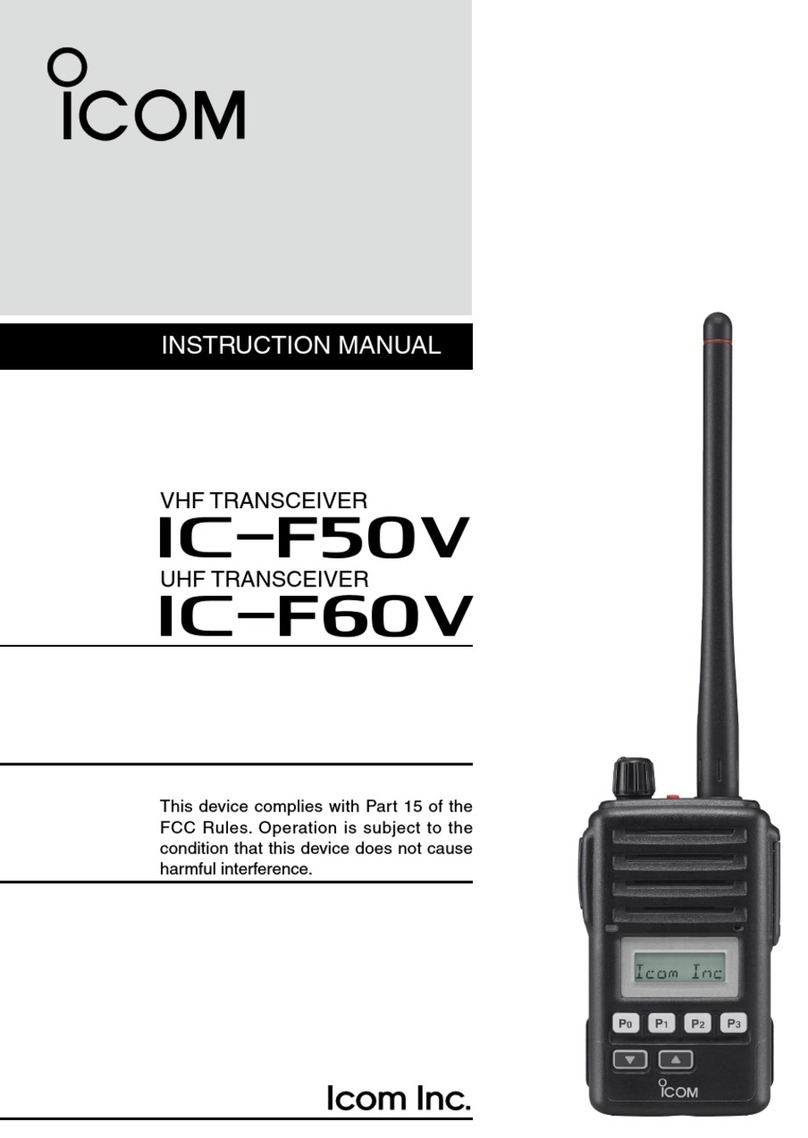
Icom
Icom IC-F50V User manual

Icom
Icom IC-746 User manual
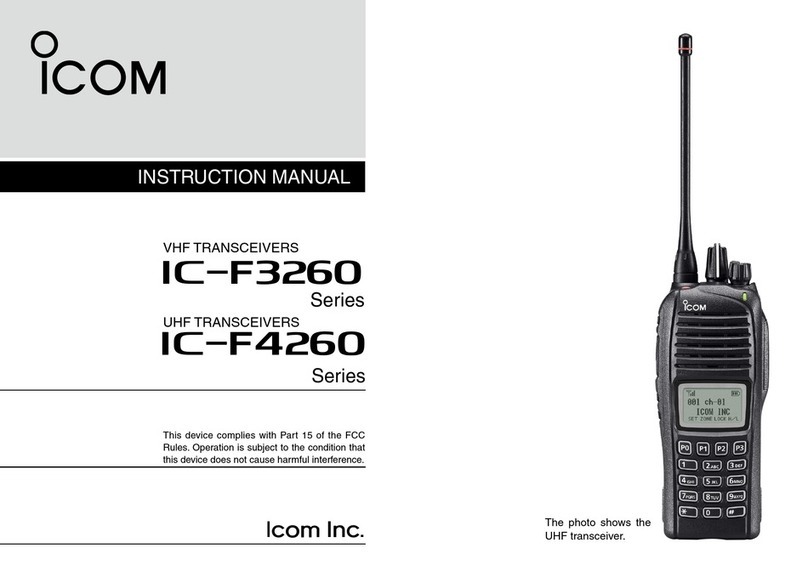
Icom
Icom IC-F3260 Series User manual
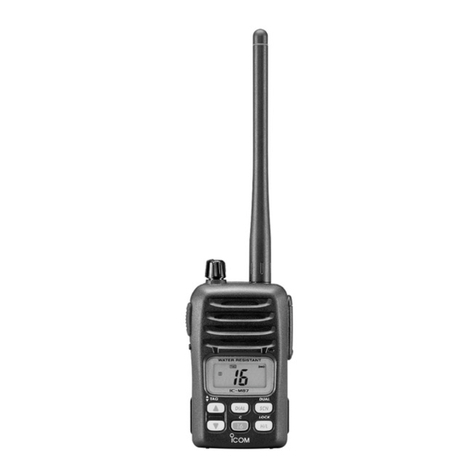
Icom
Icom IC-M87 User manual
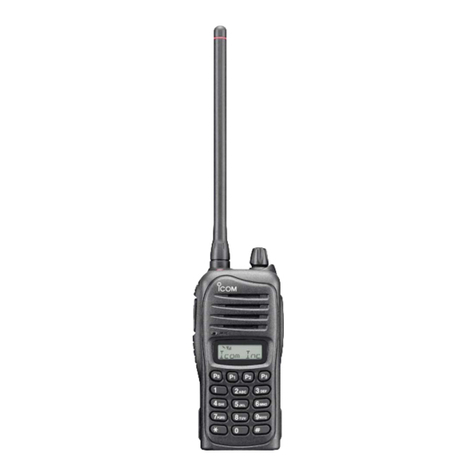
Icom
Icom IC-F3023T User manual
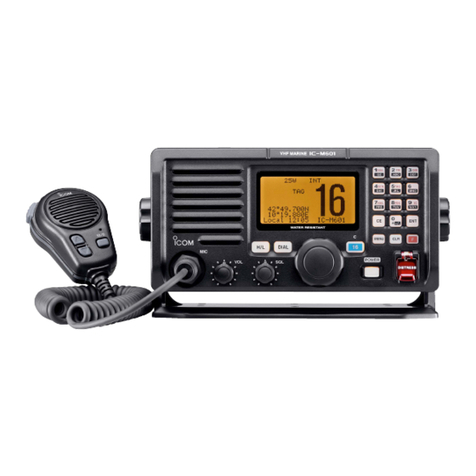
Icom
Icom IC-M601 User manual
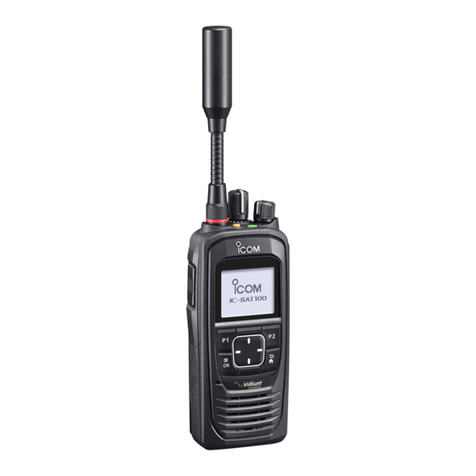
Icom
Icom IC-SAT100 User manual

Icom
Icom IC-F29DR User manual

Icom
Icom VHF MARINE TRANSCEIVER IC-M501EURO User manual
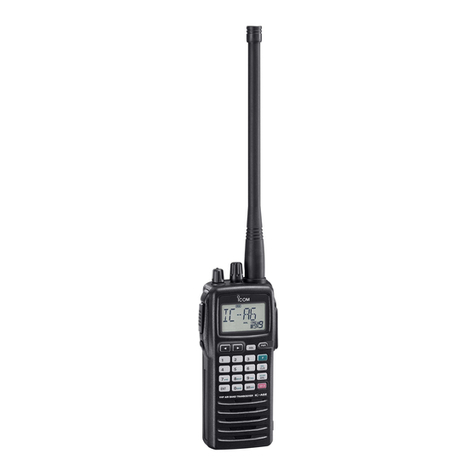
Icom
Icom IC-A24 User manual
